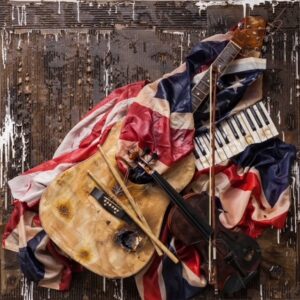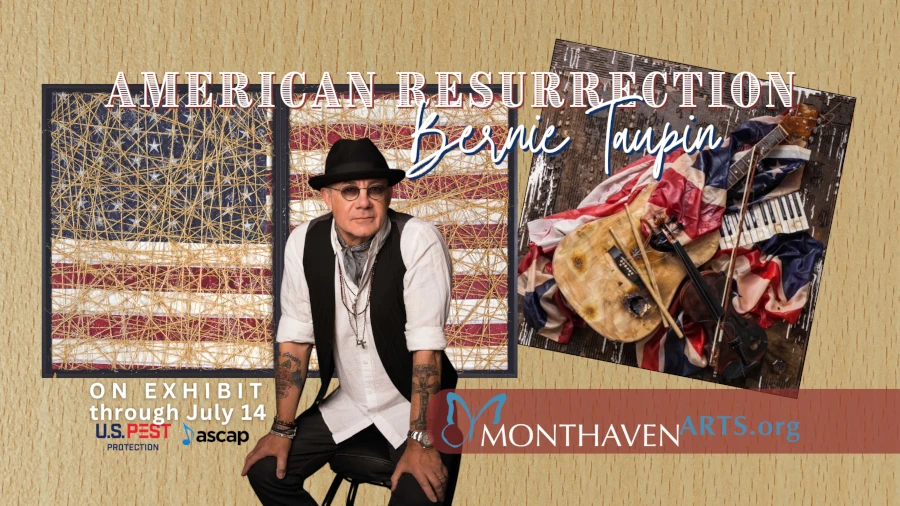Bernie Taupin’s lifelong love for America comes through loud and clear in American Resurrection, a terrific exhibition on display through July 14, 2024 at Monthaven Arts and Cultural Center in Hendersonville, Tenn. The English-born American songwriter and artist discusses his music, art, patriotism and fascination for the American West in a wide-ranging conversation with MACC Executive Director Cheryl Strichik.
Bernie Taupin was born in Lincolnshire, England in 1950, the son of a soldier-turned-farmer and an art-loving mother. He developed a sense of patriotism from his father, who fought in the British Army during WWII. His mother sparked his early interest in the arts. Taupin’s fascination with the American West began after hearing American singer Marty Robbins’ album Gunfighter Ballads and Trail Songs. Robbins’ knack for storytelling captured the young Taupin’s imagination and convinced him that he wanted to write songs.
Taupin first came to the United States in 1970 with his songwriting partner Elton John. Making his U.S. debut at the Troubadour in Los Angeles, Elton performed songs from Tumbleweed Connection, which included some of Taupin’s most inspired lyrics about the American West. Taupin moved to the United States in the mid-1970s, and he became an American citizen in 1990. Around the same time, he began experimenting with the visual arts and also became a California rancher. He discusses his life’s journey in his vivid memoir Scattershot. Taupin sums up his love for his adopted country in the following essay about the American flag:
RAGGED GLORY By Bernie Taupin
 My father was a quiet soldier who went to war in the desert fighting Rommel’s Afrika Corps before he became part of the “Forgotten Army” that pushed the Japanese out of the jungles of Burma. He won several medals for bravery, but never discussed his experiences. Reserved and modest, he chose to store them away until I grew to an age where my inquisitiveness forced his hand. Needless to say, he remained a soldier all his life even after he was long out of uniform. I say this with a sense of pride; I also say it as a means to establish my feelings for symbols of patriotism, the foremost being the flag that flies above that which we serve.
My father was a quiet soldier who went to war in the desert fighting Rommel’s Afrika Corps before he became part of the “Forgotten Army” that pushed the Japanese out of the jungles of Burma. He won several medals for bravery, but never discussed his experiences. Reserved and modest, he chose to store them away until I grew to an age where my inquisitiveness forced his hand. Needless to say, he remained a soldier all his life even after he was long out of uniform. I say this with a sense of pride; I also say it as a means to establish my feelings for symbols of patriotism, the foremost being the flag that flies above that which we serve.
Of all the flags of all the nations, you would be hard pressed to find one having a more far-reaching effect on the psyche of the world than our Stars and Stripes. There are flags, and there are flags, and then there is Old Glory, its dramatic symbolism and powerful connotations reverberating with undeniable influence. Nations may quibble, but no other country displays its flag with more diligence and fervor than the U.S. On the main street of my little town in Southern California, you can stand in the gas station and see eight American flags flying above grocery stores, barber shops, coffee houses, schools and private homes. There is a bond between the American people and their flag that cannot be duplicated anywhere else in the world. The handling of the flag, however, comes with an explicit set of rules, and this is where ideology and interpretation can clash.
 There is a rigid respect and almost clinical kid-glove approach to flag etiquette that one might argue seems ironic given its history. It’s a touchy subject made all the more sensitive given the nature of my work that some may interpret as disrespectful. Rest assured my motives are honorable. Every slash and burn, every stain and embellishment, all the billowing, twisting and folding, stitching and deconstruction are intended to project a sense of strength and resilience in the face of abject adversity. The correct way to dispose of a flag is by destroying it in a dignified manner preferably by burning it, while my way of respecting it is by breathing new life into it.
There is a rigid respect and almost clinical kid-glove approach to flag etiquette that one might argue seems ironic given its history. It’s a touchy subject made all the more sensitive given the nature of my work that some may interpret as disrespectful. Rest assured my motives are honorable. Every slash and burn, every stain and embellishment, all the billowing, twisting and folding, stitching and deconstruction are intended to project a sense of strength and resilience in the face of abject adversity. The correct way to dispose of a flag is by destroying it in a dignified manner preferably by burning it, while my way of respecting it is by breathing new life into it.
The United States flag has been shot through, shot down, trampled underfoot and hidden under the floorboards of POW camps. She’s been defaced by our enemies, ripped by ill winds, raised at Iwo Jima and rescued from the rubble of 9/11. Between 1777 and 1960, the flag has changed face 27 times embracing its extended horizon. It has forged heroes and inspired poets, painters and authors.
It is celebrated in song and eulogized like a living breathing entity. I am equally as thrilled as others by the reverence afforded her and the pageantry that unifies great crowds whenever our anthem is played, and that pristine beauty snaps in the wind. Having said that, I think I’m always going to be a little bit in love with the organic grass roots version, slightly rough around the edges and flapping above some small-town country courthouse – that ragged old glory.
VIDEO PRODUCER: Jonah Pitcher


